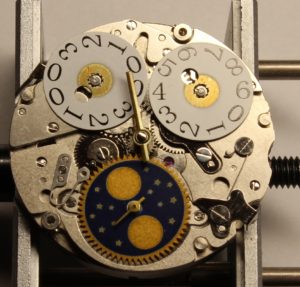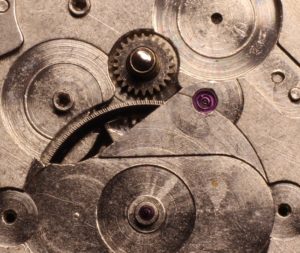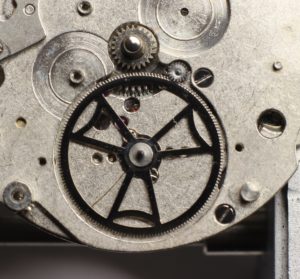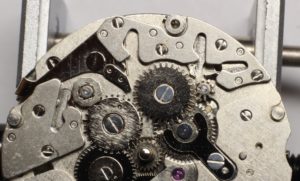This is an automatic movement with moonphase and big date. This movement was full of surprises as cost considerations have led to decisions that go against what engineering logic would dictate. At first, I was not thinking of disassembling the base movement as my focus was on the dial-side complications. However, when I removed the moonphase disk and realised the seconds hand was not directly driven, I took a look at the base movement and had quite a surprise. The movement has a seconds’ hand at 6 o’clock and a central minute hand, whereas the base movement has a central fourth wheel and a decentralized main wheel. My second surprise was that the complications are a module placed on top of the base movement rather than being integrated into its bottom plate (the lack of keyless works should have been obvious, but I was focused on the complications and I’ve seen pocket watches with keyless works on the top side).
Below is a picture of the full movement, with the small seconds at 6 o’clock within the moonphase disk. As you can see, the keyless works are not visible at this point as everything you can see here is a module mounted on top of the base movement.
 The next picture focuses on the big date complication. The left disk has the zero repeated twice in order to have a total of 10 digits and therefore the same font size as the other disk.
The next picture focuses on the big date complication. The left disk has the zero repeated twice in order to have a total of 10 digits and therefore the same font size as the other disk.
 The picture below shows the moonphase. On the left, the spring ensures the disk moves only by one increment. On the right, the moonphase adjuster and its spring.
The picture below shows the moonphase. On the left, the spring ensures the disk moves only by one increment. On the right, the moonphase adjuster and its spring.
 The moonphase wheel is driven by the hour wheel and has a pin that will turn the moonphase disk by one increment every day.
The moonphase wheel is driven by the hour wheel and has a pin that will turn the moonphase disk by one increment every day.
Let’s now turn to the big date complication. The hour wheel dives a first intermediate wheel, which drives a second, which drives both the pinion for the ones disk and another intermediate wheel that drives the pinion for the tens disk.
The first intermediate wheel, which is driven by the hour wheel, has a finger that turns the next wheel by one increment every day.
 The second intermediate wheel drives both the pinion for the ones disk and another intermediate wheel. It has two levels of teeth, one of which has 2 teeth missing. I understand it missing 1 tooth as 31 and 1 follow each other and have the same ones digit, but I don’t understand why it is missing a second.
The second intermediate wheel drives both the pinion for the ones disk and another intermediate wheel. It has two levels of teeth, one of which has 2 teeth missing. I understand it missing 1 tooth as 31 and 1 follow each other and have the same ones digit, but I don’t understand why it is missing a second.
 The next intermediate wheel, which drives the pinion of the tens disk, has some teeth that are longer than the others. Only the longer teeth move the pinion. They are not at regular interval, but move the tens disk at 5 (from 0 to 0 because as can be seen on the first picture of the disk above, it has 2 zeros in a row for font size purposes), at 10 (from 0 to 1), at 20 (from 1 to 2), at 30 (from 2 to 3), and at 32/1 (from 3 to 0).
The next intermediate wheel, which drives the pinion of the tens disk, has some teeth that are longer than the others. Only the longer teeth move the pinion. They are not at regular interval, but move the tens disk at 5 (from 0 to 0 because as can be seen on the first picture of the disk above, it has 2 zeros in a row for font size purposes), at 10 (from 0 to 1), at 20 (from 1 to 2), at 30 (from 2 to 3), and at 32/1 (from 3 to 0).
 Now taking a look at what is under the moonphase disk, we can see a large wheel.
Now taking a look at what is under the moonphase disk, we can see a large wheel.
 Once the moonphase plate is removed, the wheel is visible, as is a small pinion at one o’clock that goes through the main plate and is driven by the fourth wheel of the base movement.
Once the moonphase plate is removed, the wheel is visible, as is a small pinion at one o’clock that goes through the main plate and is driven by the fourth wheel of the base movement.
 On the next picture, the whole module plate has been removed, revealing the keyless works.
On the next picture, the whole module plate has been removed, revealing the keyless works.
 Finally, a picture of the base movement with the rotor, automatic bridge, and gear train bridge removed. The base movement has a central fourth wheel and a decentralized main wheel, which is why additional wheels on the dial side had to be used to bring the minutes back to the cannon pinion and the seconds in the sub-dial at 6 o’clock.
Finally, a picture of the base movement with the rotor, automatic bridge, and gear train bridge removed. The base movement has a central fourth wheel and a decentralized main wheel, which is why additional wheels on the dial side had to be used to bring the minutes back to the cannon pinion and the seconds in the sub-dial at 6 o’clock.


